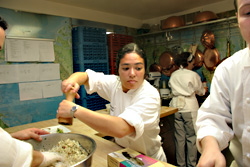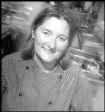Chef Maria Hines, 33, is the diminutive head toque at the Seattle W Hotel’s Earth & Ocean restaurant, but this day, April 19, she’s reaping the harvest of weeks of planning and days of food prep for one of the most formidable catering jobs in America.
We’re at the James Beard House, a Greenwich Village brownstone that was once the home of its namesake, the American gourmand and author. The home is now the national headquarters of the philanthropic organization that bears Beard’s name and promotes gastronomy and the culinary profession. Hines is here to cook a Beard House dinner, an invitational honor that requires a chef to donate thousands of dollars in food, labor, and expenses in order to cook for a pack of 80 picky Manhattan foodies, whom they hope will be an appreciative audience. In return, the chef gets national recognition, a hot résumé bullet point, and introduction into a headier culinary circle.
A year or so after winning her first executive chef job at the prestigious hotel restaurant from which Johnathan Sundstrom (now chef-owner of the swell-reviewed Lark) launched himself nationally, Hines was named one of Food & Wine magazine’s 2005 Best New Chefs and was hoisted up on the national stage. She’s been acclaimed by critics as a cook of uncommon simplicity, brilliance, and ambition.
But New Yorkers have a habit of making up tough crowds, and tonight’s hors d’oeuvres—a time-consuming production of “steak and eggs” that pairs quail eggs with house-made charcuterie, a slice of caperberry, and Dijon mustard on crostini—are as fussy as the guests. Hines is easygoing throughout, but when the appetizers have all been passed and it’s show time, Hines’ demeanor changes to all business.
First comes porcini mushroom crème brûlèe, a savory flan whose cream has been steeped with wild porcinis. It’s baked in shallow individual ramekins, with dark, coarse Demerara sugar sprinkled atop and blowtorched into a thin, caramelized crust. The ramekins go on square plates with a dollop of vanilla foam that lead cook Ashley Merriman froths by using an immersion beater in a saucepan of warm, vanilla-flavored milk. The foam is peaky, but will look like pond scum after only a few minutes, so plates can’t linger in the kitchen. A tiny salad of frisée is painstakingly meted out onto each plate with a closely supervised intern’s gloved hand. Hines adds a diagonal line of French sea salt and porcini dust and pushes firmly on the servers to move ’em out. It’s a dream to eat—a mushroom cloud, all cream and crunch and subtle, salty-sweet.
There were rumors for years that doing a Beard House dinner was a quid pro quo for getting the prestigious Beard Award. “No one believes that anymore,” says Tom Douglas, owner of the Dahlia Lounge and three other popular Seattle restaurants. He might be considered living proof; he won the 1994 award for Best Northwest Chef but never cooked a Beard House dinner. (Seattle chefs who have orchestrated a Beard dinner but not received the Best Chef award include Monsoon’s brother-sister team Eric and Sophie Banh and Nell’s Philip Mihalski.)
If not an implicit trade-off, are Beard House dinners unofficial requirements for chefs looking to launch a national career or make their restaurant’s reputation? Douglas says, “I was more into that stuff when the Dahlia was in its younger years, but spending [$10,000 to $15,000] to go back there and cook was not where I wanted to spend my money.”
Jason Wilson, chef-owner of Madison Valley’s Crush, says, “It’s a major recognition and important to chefs. Like dairy products, we have expiration dates, too. The Beard dinner and the awards give public recognition that a chef has staying power. For a chef’s overall career, it’s a very, very positive thing.”
While most foodies and industry professionals would agree with Wilson, the nonprofit’s heft and prestigious reputation took a beating last year when longtime President Leonard E. Pickell pleaded guilty to second-degree grand larceny in the theft of more than $50,000 from the organization. State prosecutors told the judge that Pickell actually stole more than $1.1 million. He went to prison, the board resigned, and now, the organization seems to be on its way to recovery.
But there are other reasons independent chefs cannot always accept the honor of cooking a Beard House dinner. These things are a huge investment—not just of money, but also of time and workforce power. Most of the prep must be done at home and flown across the country. For days and weeks prior to the event, Hines and her E&O crew were boiling quail eggs, bagging up porcini dust and duck breasts, vacuum-packing stinging nettles, and seeing to a million other details, hoping to ensure that the shit-happens factor is reduced to a considerably less-than-normal margin of error.
Considering the great cost of picking up one’s operation—and pantry—and transporting it to the Big Apple, it’s very helpful for a chef to have a corporation willing to pay the freight. “I’m grateful for the W Hotel’s support in sending us,” says Hines.
After all, the machine must be fed: Food magazines and the Food Network create, puff up, and serve scores of fresh new food “celebrities” every year. A chef who toils in the vineyards, or in this case, sweats anonymously at a hot stove, lacks in the public eye the credibility of a chef who has worked their image, hired a flack, or taken a media intensive. This culinary star-sucking slakes a peculiarly American thirst for fame and celebrity worship, but has also made the once-dull cooking trades attractive to a wider talent pool of young people.
Back in the kitchen, sous-chef Wiley Frank, 28, dances at the big eight-burner Viking and a bank of convection ovens. The first two courses (the mushroom custard and a wild Dungeness crab salad) have been plated, and he’s as busy as a jazz drummer—first crisping the skins on 80 sockeye salmon fillets in big sauté pans covering the stove top, then transferring them, still mostly raw, onto oven sheets for the finish. Then in the pans, he renders crispy the skin on 80 Liberty Farms duck breasts. While all this crisping is going on, he’s simultaneously sautéing marbled tricolored potatoes with bacon lardons and dark green nettles and plating Yakima cherries and arugula. It’s a fast-moving spatial Olympics, as he jockeys the pans onto the blazing burners and works under the pressure of this Manhattan night.
Dessert is a persnickety dish up of E&O pastry chef Sue McCown’s famous “warm, wild, and wicked” chocolate cake, which the famously whimsical McCown calls www.chocolate.com. As the last one is being set on the plate, Hines sends Merriman out for a half rack of Brooklyn Lager, and the kitchen slaps itself on the back before touring the dining rooms to meet that now appreciative audience. Hines and company brought Northwest ingredients and Seattle smarts clear across the country and pulled off a delicious one-night stand with style and class.
“We won,” she says to her kitchen. No one in the house would dare disagree.








